Ingenious instincts: KwaZulu-Natal’s most fascinating bird breeding behaviours
Extraordinary parenting strategies and local birding tips from our forests, wetlands, and backyards
Text and photographs Nicolette Forbes
Birds are nothing short of remarkable when it comes to reproduction. KwaZulu-Natal (KZN), with its richly diverse habitats ranging from coastal dunes to mist belt forests and high-altitude grasslands, is home to a tapestry of bird species whose breeding behaviours are as varied as their habitats and plumage. From monogamous partnerships and elaborate nests to parasitic tactics and even egg mimicry, KZN’s birds showcase some of nature’s most creative strategies for ensuring the next generation survives. From cunning cuckoos to nest-weaving artists, and from cliff-top crèches to the suburban skies of Hillcrest and Kloof, the birds of KwaZulu-Natal reveal nature’s boundless creativity in reproduction.
Every birdwatcher knows that breeding season brings drama, dedication, and dazzling displays. But dig a little deeper into KwaZulu-Natal’s birdlife, and you’ll uncover a world of surprising strategies and secret lives. Whether you’re watching a brood parasite at work or marvelling at a male that does all the parenting, KZN’s birds break the rules in spectacular fashion.
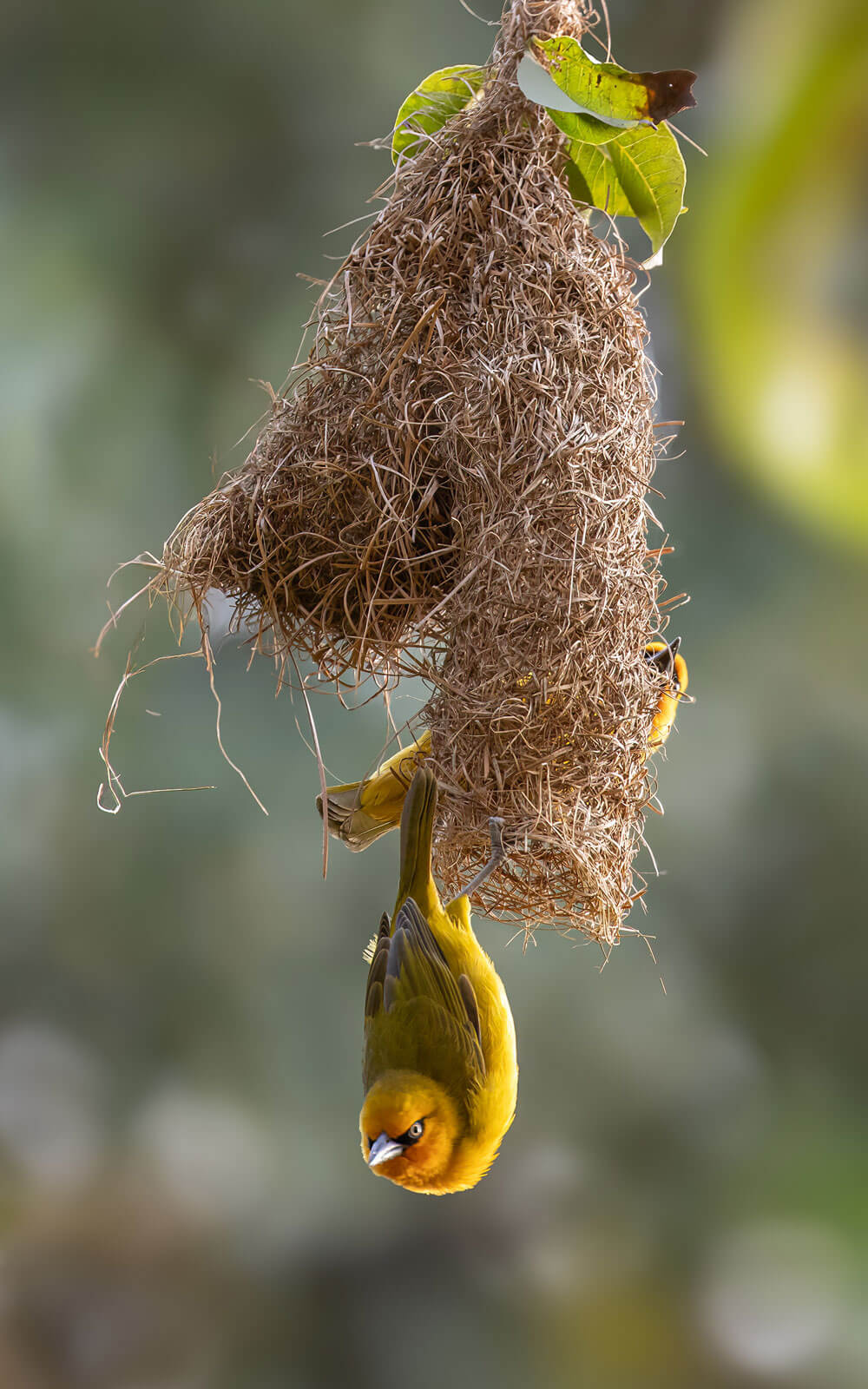
Precision and purpose: a Spectacled Weaver’s nest isn’t just eye-catching—it must meet the high standards of a critical mate.
Timing is everything
Most resident birds in the region time their breeding to align with seasonal rainfall, which typically begins in late spring. The rains trigger a flush of insect and plant life, ensuring high food availability for demanding nestlings. Insectivores like the Dark-capped Bulbul and Cape White-eye often begin nesting as early as September, making use of the spring abundance. Red-eyed Doves, however, may nest almost year-round, particularly in urban gardens where food and water are regularly available. Opportunistic breeders like the Hadeda Ibis capitalise on human-modified environments, nesting high in exotic trees or even on rooftops, often with little regard for seasonality.
Let’s take a closer look at a few standout reproductive behaviours seen in KZN species:
The secret lives of the brood parasites
Among the most fascinating and deceptive reproductive strategies is that of the brood parasites which include the cuckoos, honeyguides, indigobirds and whydahs. Cuckoos are common in the Durban area are one of these and this group never build nests of their own. Instead, the female watches and waits for the right moment to lay her egg in the nest of a host species—often unsuspecting Southern Red Bishop or Tawny-flanked Prinia.
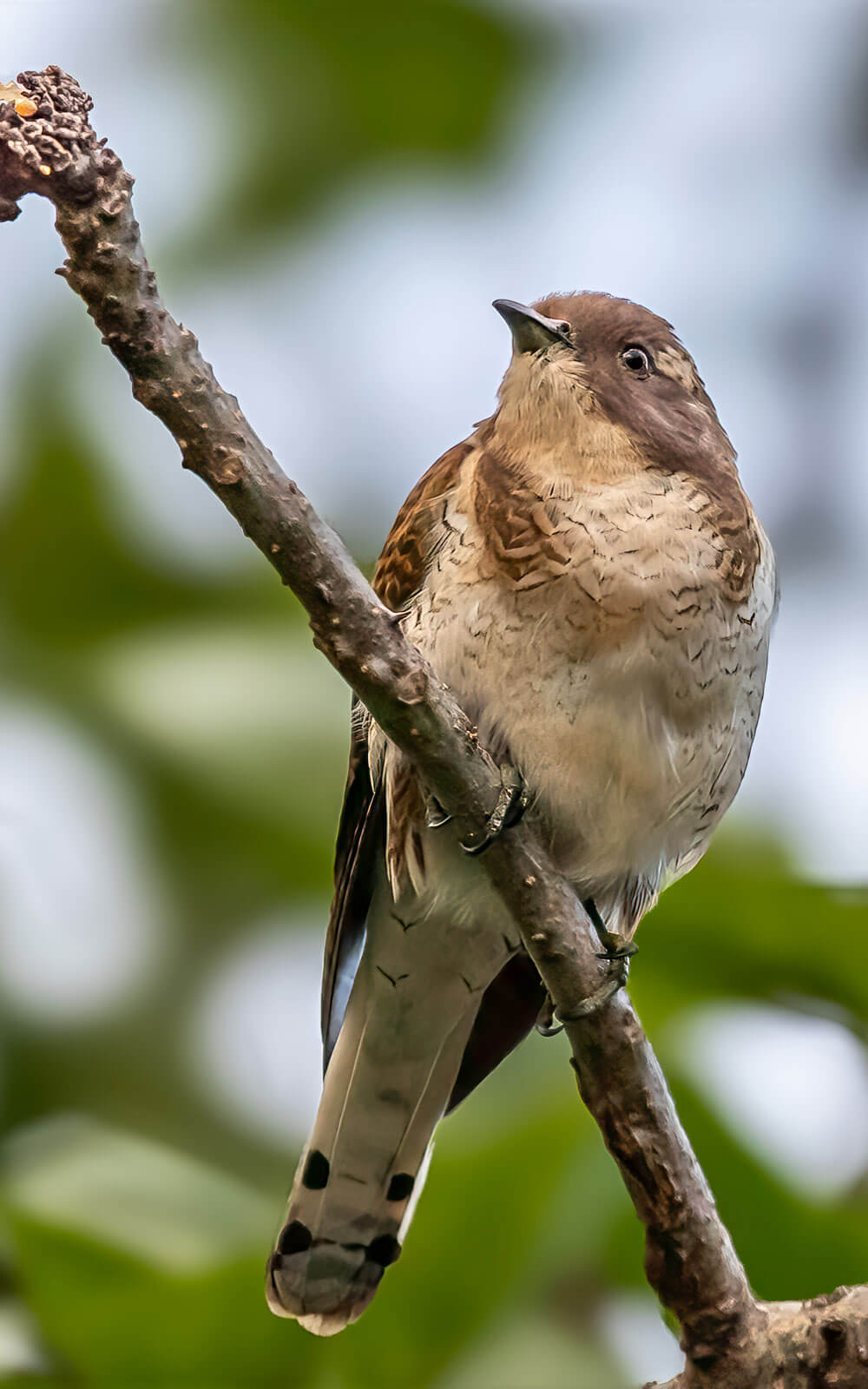
Brilliant but devious: a female Klaas’ Cuckoo watches for a chance to lay her egg in another bird’s nest.
This happens on our doorstep in the Highway area, especially around sanctuary areas like Springside Nature Reserve and Giba Gorge. Common host species are duped with one of the oldest tricks in the book and straight into raising a chick not their own. Even more astonishing is how the cuckoo chick hatches earlier, grows faster, and may eject the host’s eggs or chicks from the nest. It then monopolises the care of the foster parents, who feed it as if it were their own—evolution’s masterclass in manipulation. This sneaky strategy is highly effective and means the cuckoo skips the hard work of parenting entirely.
Weaver wonders: nature’s master builders
KwaZulu-Natal’s rivers and wetlands burst with activity during the breeding season of Village Weavers and Spectacled Weaver. These birds are not just builders—they are artists. Males weave elaborate hanging nests from grass and reeds, dangling like ornaments from trees or reeds above water. Females inspect the structure with a critical eye. If the craftsmanship doesn’t meet their standard, they’ll rip it apart. This intense selection pressure has driven the evolution of ever-more intricate nests, often completed in under a day. Males craft elaborate nests suspended from branches or reeds, using grass blades and reed strips. These hanging orbs are designed to sway and confuse predators—but they must also impress picky females. If the structure isn’t just right, the female may brutally dismantle it, leaving the male to start again.
The result? Some of the most intricate and resilient avian architecture in Africa.
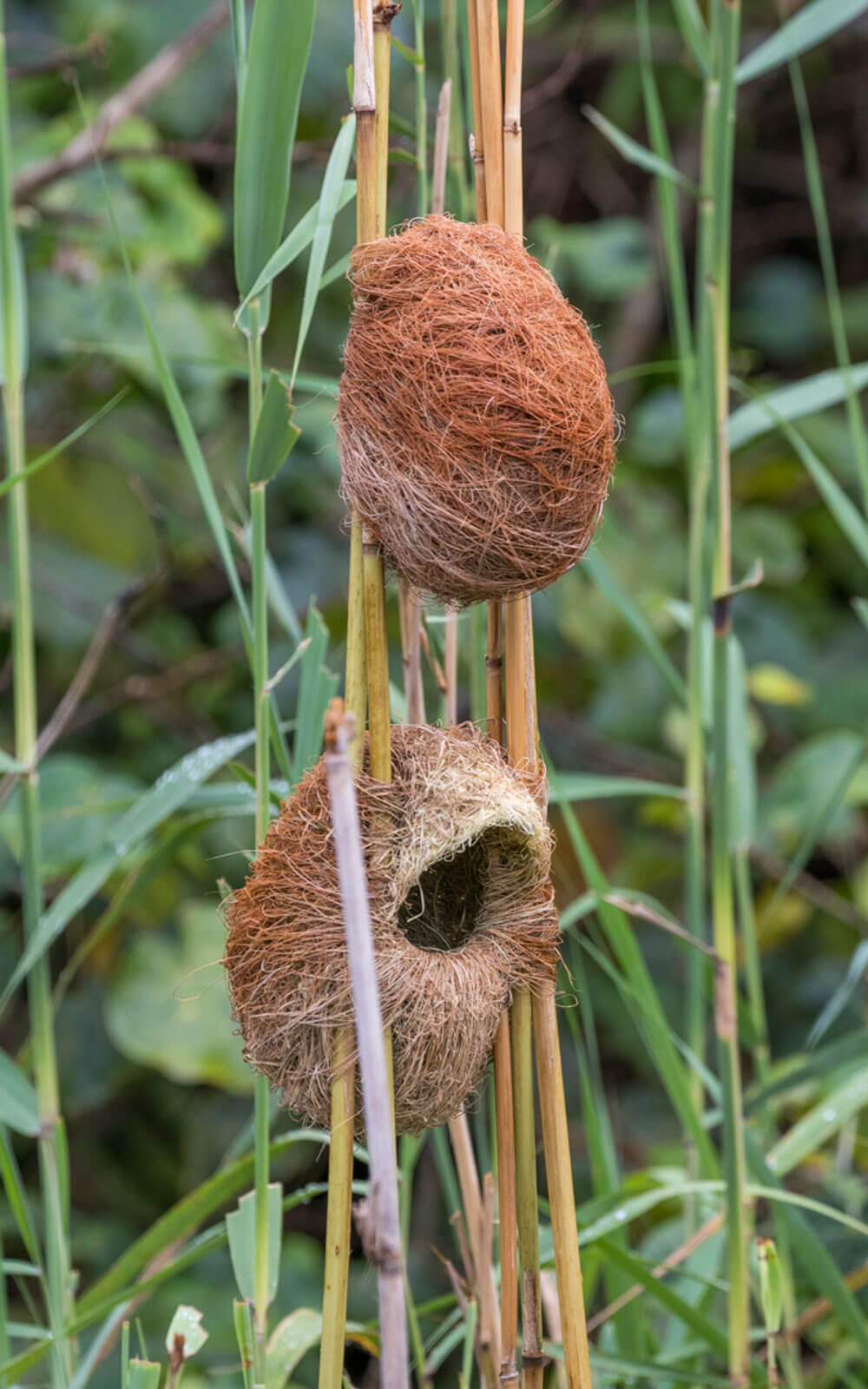
A Thick-billed Weaver nest – neat and made with careful precision
These nests also deter predators and offer protection from flooding—a necessity in KZN’s summer rainfall zones. Come summer, the riverine areas, dams and wetlands near Glenholme Nature Reserve and Paradise Valley are abuzz with the frantic activity of Village and Southern Masked Weaver.
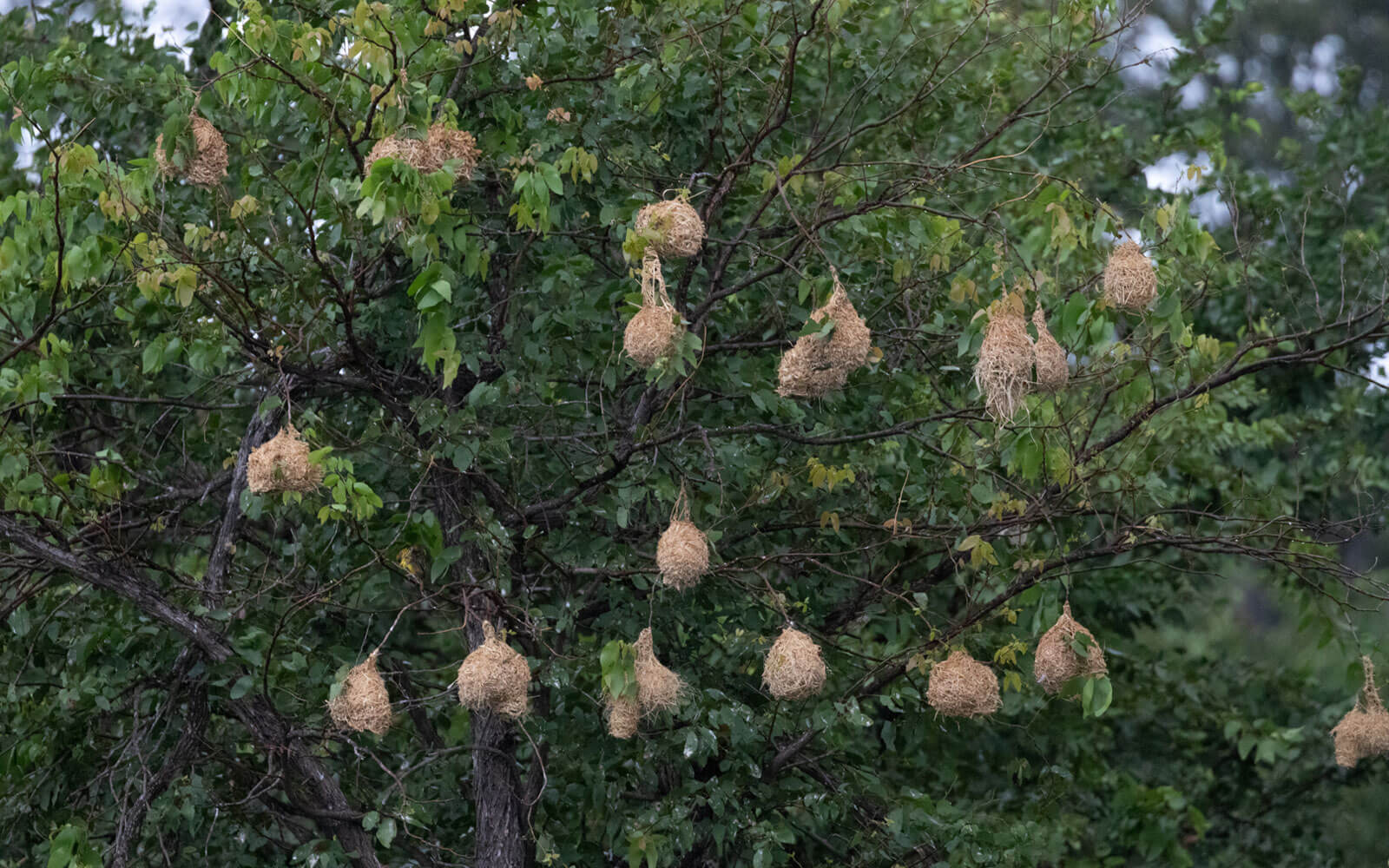
Suburban spectacle: weaver colonies provide constant activity during the summer breeding season.
Parental behaviours and nest defence
Parental investment also varies widely. Altricial species, such as many forest songbirds, hatch blind and featherless chicks requiring intensive feeding and care. In contrast, precocial chicks, like those of the Egyptian Goose or Helmeted Guineafowl, are born downy and mobile, following parents soon after hatching.
Nest defence is another critical component—White-browed Robin-Chats may feign injury to lure threats away from their nests, while Blacksmith Lapwings aggressively mob intruders. Cooperative breeding is seen in species like the Southern Black Tit, where offspring from previous seasons assist in rearing the next generation—a behaviour more common in stable territories like KZN’s savannas and forests.
Force-fed fledging: raptor parenting with a twist
In the skies above the Highway suburbs, raptors like the Black Sparrowhawk or African Goshawk can often be seen hunting or circling silently. But their parenting techniques are anything but quiet. As the young near fledging age, the adults deliberately reduce feeding visits—sometimes bringing one last tempting meal and flying off just out of reach. This entices the young bird to take its first brave flight in pursuit. It’s tough love—but it works. This “last supper” strategy is critical for developing flying and hunting skills. The dense forests of Kloof and the nearby Krantzkloof Nature Reserve provide the perfect proving ground for these young raptors.
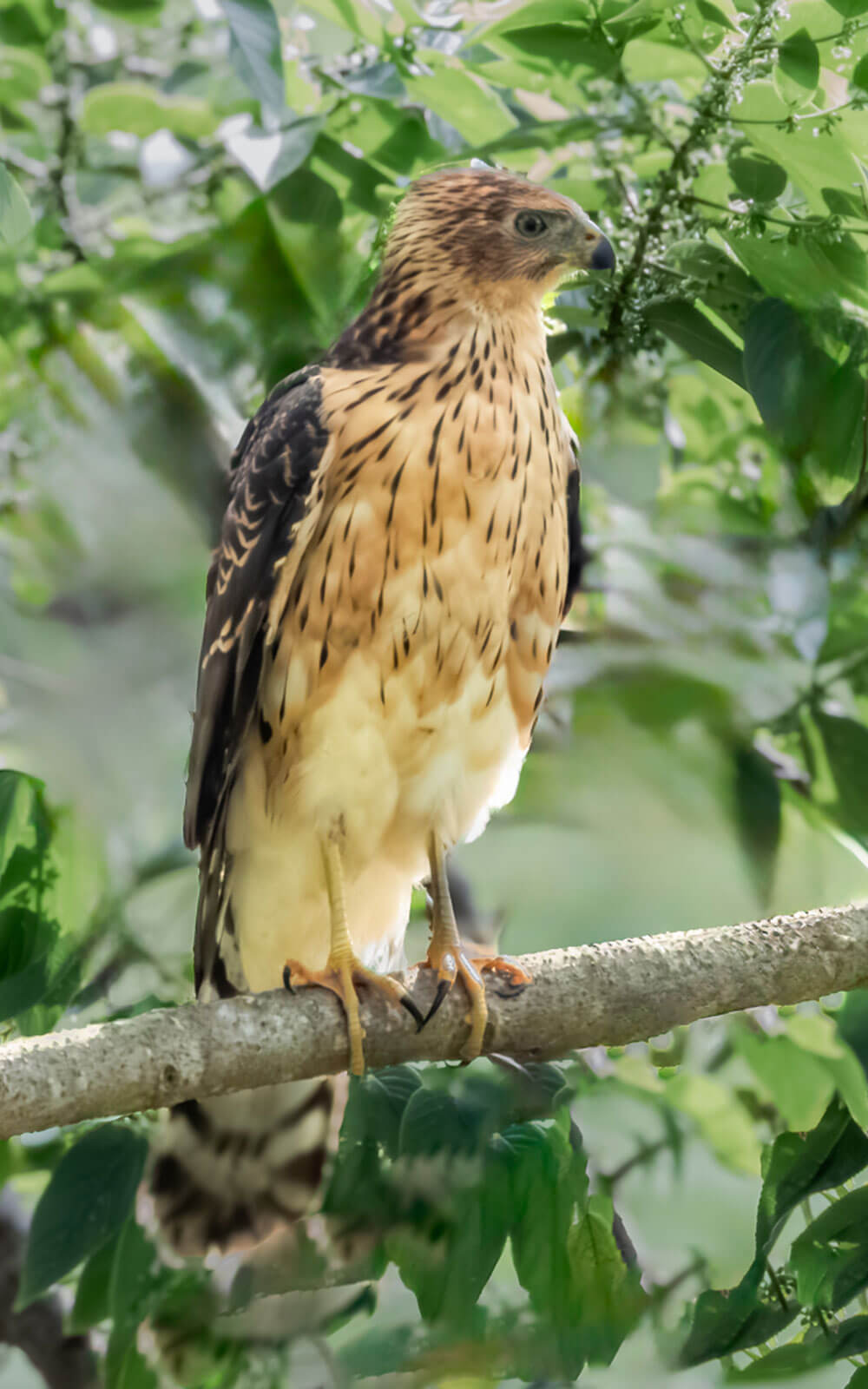
Temptation tactic: a young newly fledged Black Sparrowhawk. Raptors like the Black Sparrowhawk use food bribes to coax reluctant fledglings from the nest. Young raptors leave the nest, driven by hunger and the lure of a meal.
Dads in Charge | Role reversal
Although all birds lay eggs, African Jacanas flip the script on traditional parenting roles. This species, found in moist grasslands and reedbeds of northern KZN, is polyandrous—females mate with several males, and it is the males that incubate the eggs and raise the chicks. This reversal turns many expectations of avian reproduction on their head. The male does all the brooding and feeding while the female moves on to mate again, an intriguing example of evolutionary gender flexibility.
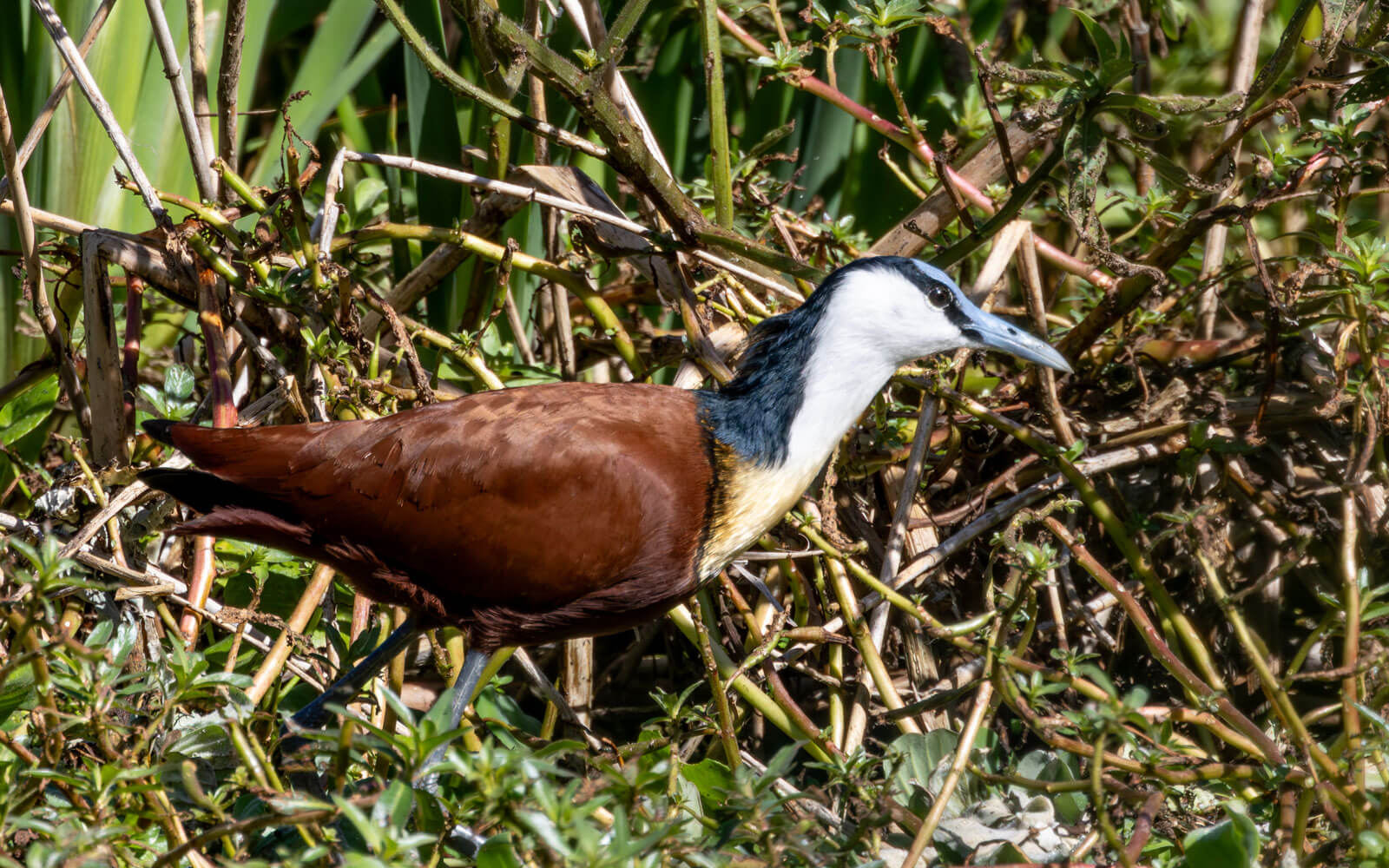
Dad does it all: In a rare reversal, the male African Jacana incubates and raises his chicks alone.
Nest choices as unique as the birds
Nest architecture across KZN’s birdlife is equally diverse. Species like the Village Weaver construct intricately woven hanging nests from grass and reeds, typically over water or at the ends of branches to deter predators. Hamerkops are famed for their colossal domed nests, sometimes reused by other species. Ground-nesters like the African Wattled Lapwing rely on camouflage and open spaces to guard against predators, while tree-cavity nesters such as the Black-collared Barbet depend on old woodpecker holes or natural hollows. Some species like the Southern Red Bishop nest colonially in reedbeds, while others, like the Crowned Eagle, build large platform nests high in forest trees and reuse and enlarge them year after year.
Some highlight examples of where—and how local species to the highway area—they nest:
- On the Krantzkloof gorge cliffs, raptors like Crowned Eagle nest on precarious ledges, or in large trees making aerial approaches their safest defence.
- In suburban gardens, White-bellied Sunbirds tuck tiny cup nests in aloes and eaves, while Hadeda Ibises create scrappy platforms in tall trees or on cell towers.
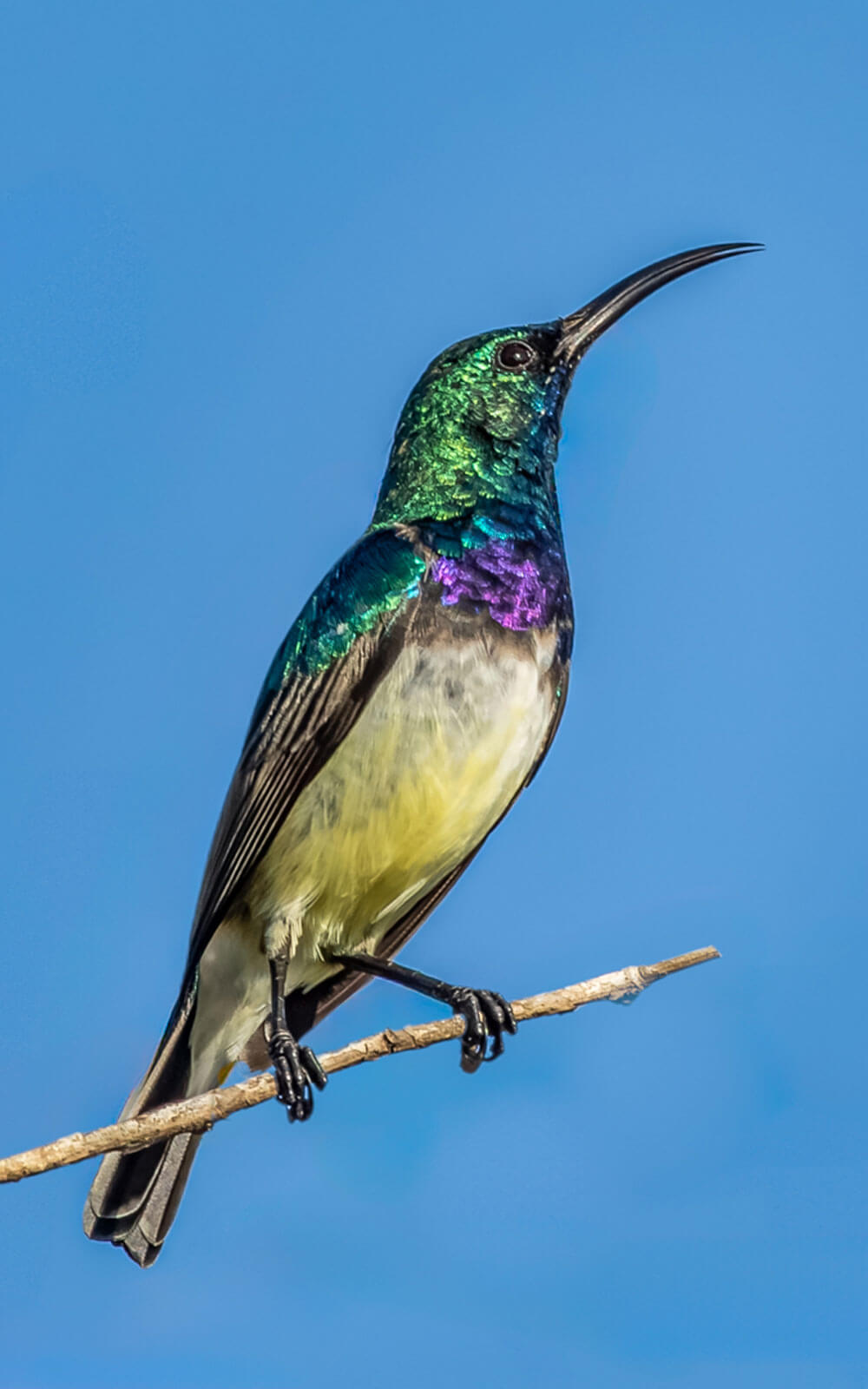
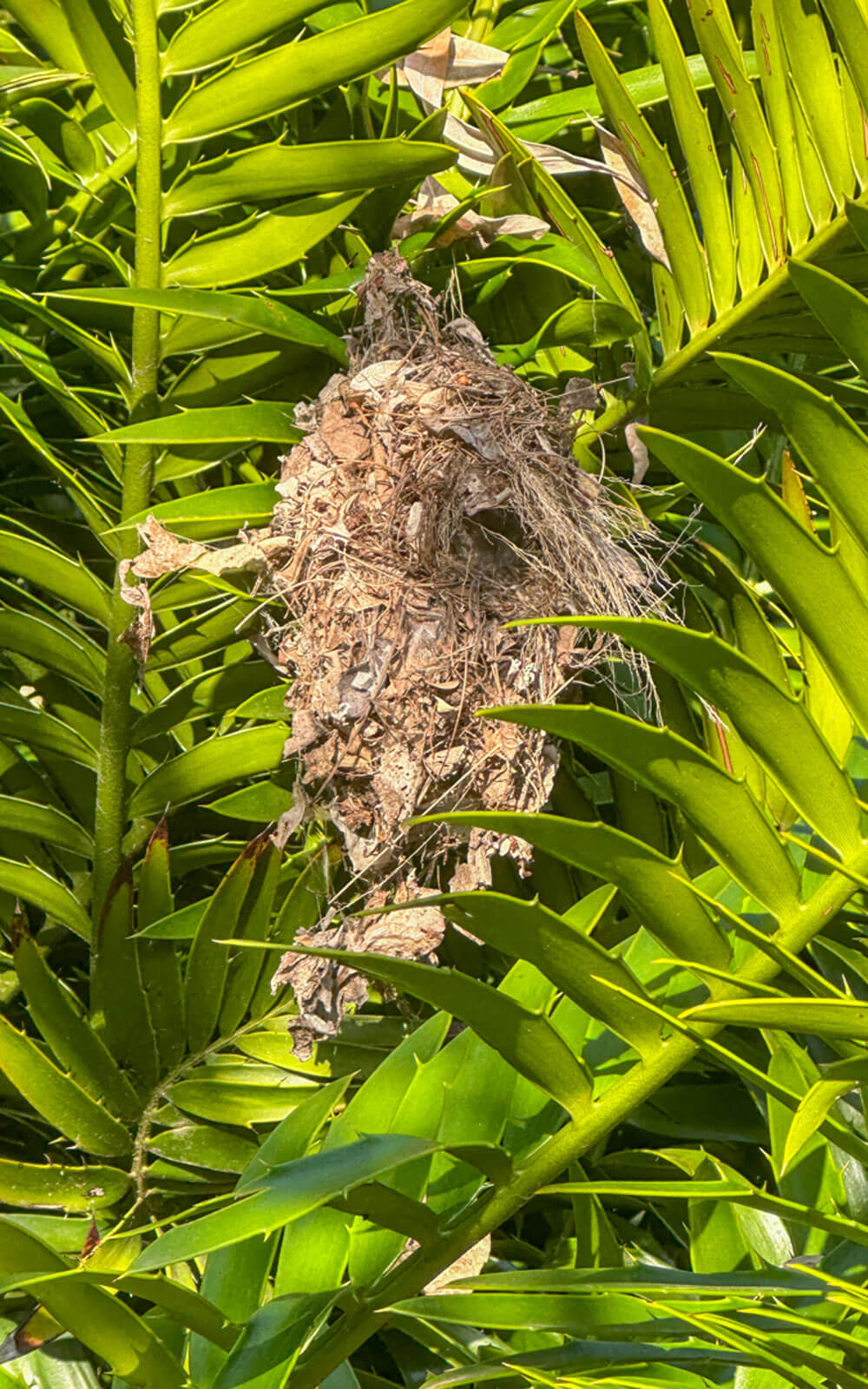
Garden treasures: urban-adapted sunbirds like the White-bellied Sunbird (left) make creative use of sheltered spots to build their nests. Here a White-bellied Sunbird nest (right) is tucked into a Kloof garden cycad complete with prickly leaf protection
- In forests, the many hole nesters like Green Woodhoopoe and White-eared Barbet create nests in tree cavities—highlighting the conservation value of mature forest trees.

A White-eared barbet peering from a tree nest cavity. Home in a hollow: Hole nesters generally rely on old trees for their nesting sites—another reason to protect our mature forests.
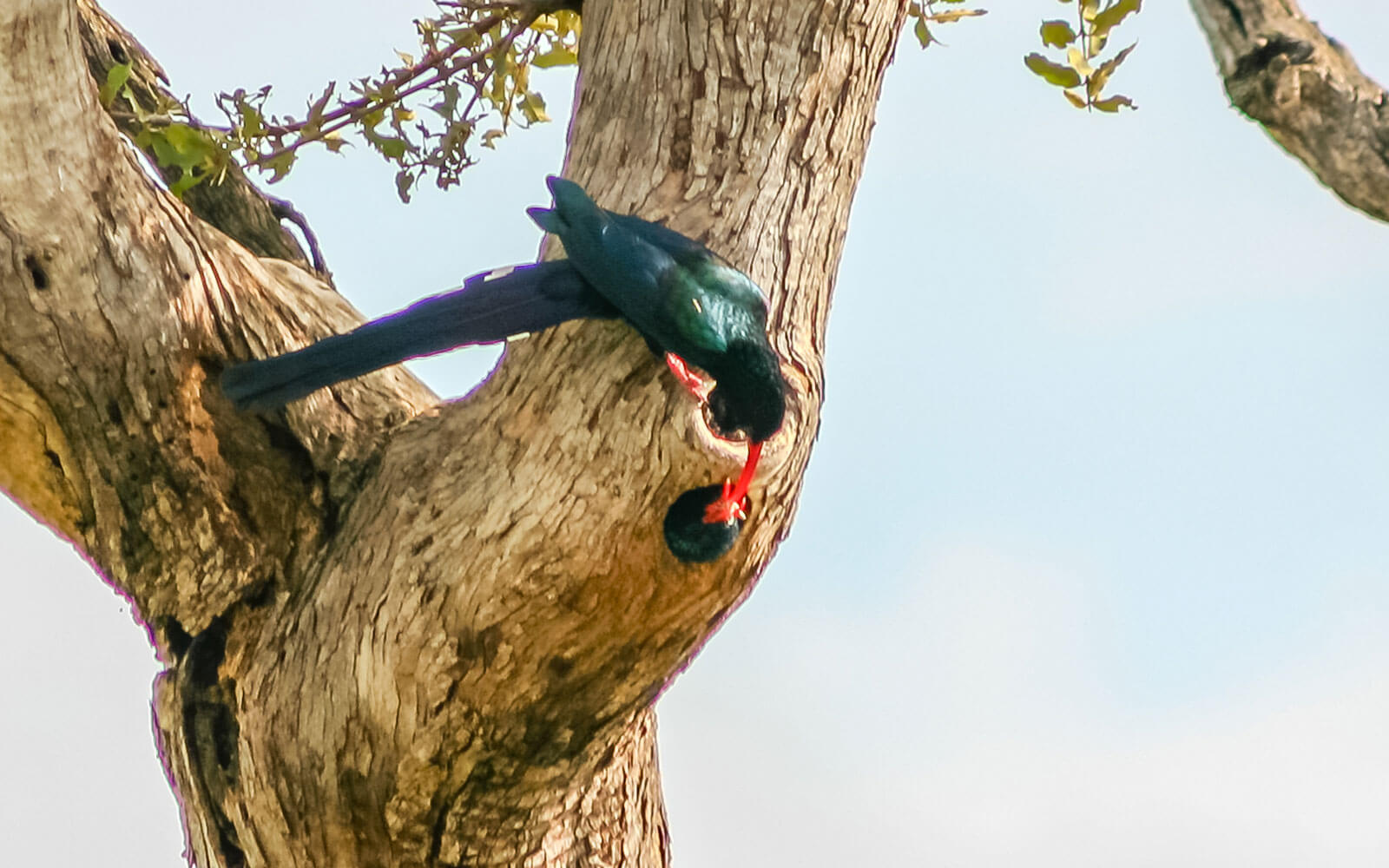
Green Wood-hoopoe, nest in tree cavities and live cooperatively in groups. Only one pair breeds, while the others help raise the young—avian teamwork in action.
Adaptations in urban and rural landscapes
Many resident birds in KZN have shown remarkable adaptability to human-modified landscapes. Species like the Speckled Pigeon and Cape Wagtail nest in gutters, crevices, and even on outdoor light fittings and clothes on washing lines, a strange but true mimic of natural cliff or riverbank sites. Some birds alter their breeding season slightly to avoid disturbances in built-up areas. Meanwhile, forest and grassland specialists continue to rely on well-preserved habitats within nature reserves and conservancies for successful breeding, highlighting the importance of habitat conservation in the region. KZNs birds coax, con, construct, collaborate—and sometimes just cleverly conspire—to raise the next generation. Whether you’re birding in the forests of Kloof or the wetlands of Zululand, these intimate glimpses into breeding behaviours turn each sighting into a small miracle.
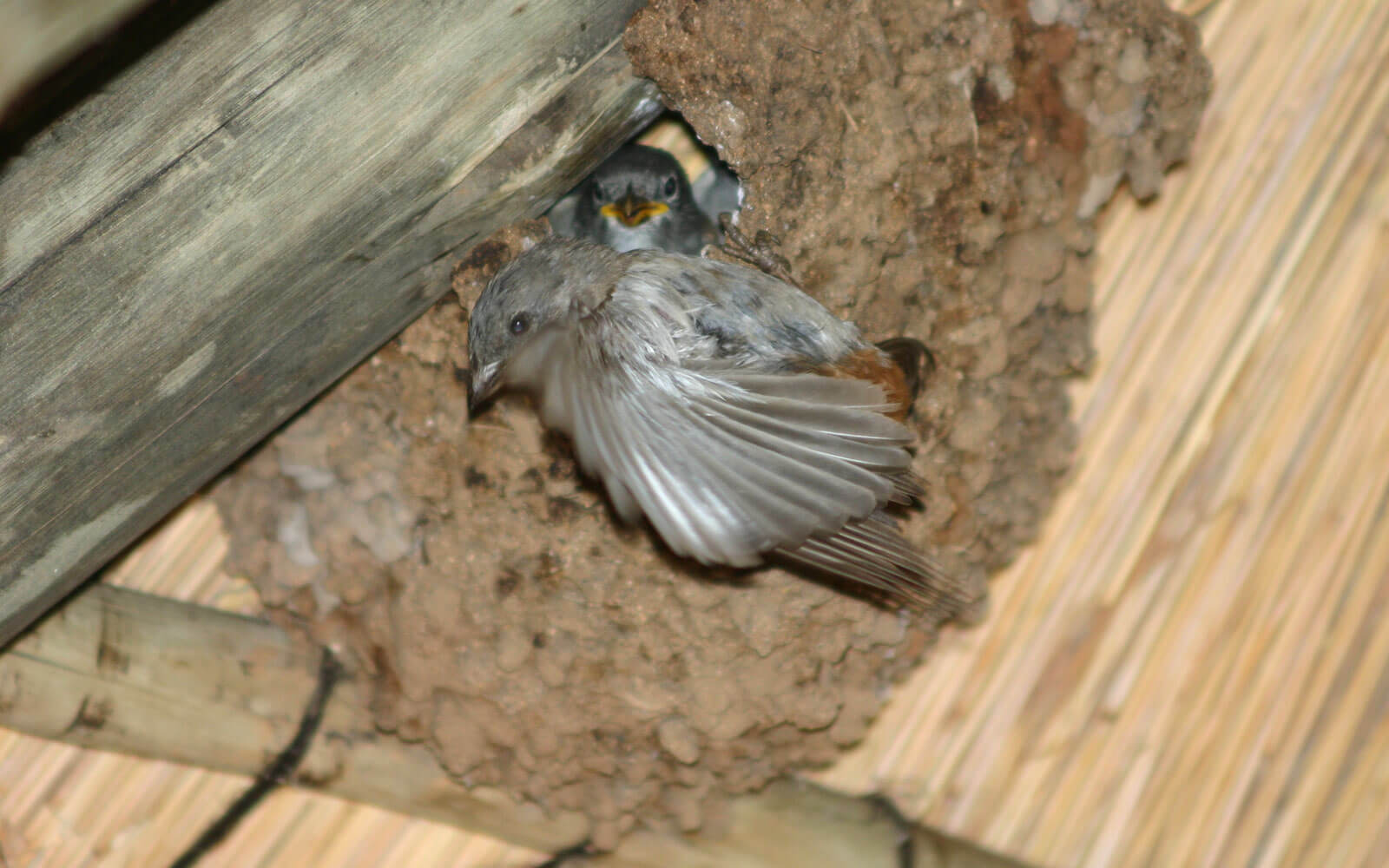
A Southern Grey-headed Sparrow making use of eves for a sheltered spot to raise their chicks.
Conclusion: a symphony of survival
Bird reproduction in KZN is a symphony of survival strategies shaped by geography, climate, and evolutionary arms races. Whether through cunning parasitism, architectural finesse, role reversals, or social cooperation, the birds of this region remind us that nature’s ingenuity knows no bounds. Protecting the varied habitats that support such reproductive marvels—wetlands, forests, cliffs, and grasslands—is vital not only for the birds but for the ecosystems that depend on them.
Final thoughts: a province full of parenting prowess
Bird breeding is a time of extraordinary energy, drama, and beauty. Whether you’re scanning a reedbed for bishop colonies or watching a robin-chat feed its chicks in a shaded garden corner, there’s no better reminder that life is constantly unfolding—often just beyond the windowpane. So the next time you spot a bird with a beak-full of insects or hear the shrill cry of a fledgling, know that you’re witnessing one of the most incredible chapters of the avian life cycle.
Birding close to home: tips for the Highway area
Tips for breeding season birding in the Highway area
- Visit early in the morning during spring and summer to observe nest-building or feeding activity.
- Palmiet Nature Reserve is a hotspot for Mountain Wagtails, which nest on riverbanks—look for them carrying food along rocky streams.
- Krantzkloof Nature Reserve offers excellent chances to spot nesting forest species like Narina Trogons and African Emerald Cuckoos.
- In your garden, provide bird-safe water sources, nesting boxes, and indigenous plants to attract nesting activity.
- Keep your cats indoors during breeding season—ground-nesting and fledgling birds are particularly vulnerable.
- Early mornings are best – start just after sunrise for maximum activity. Look and listen for alarm calls, which often signal nearby
predators or raptors. - Carry binoculars and a notebook – note nesting behaviours like food deliveries, alarm calling, or adults carrying faecal sacs away—sure signs of an active nest.
- Join a bird club to learn about bird identification, life strategies and behaviours from like minded-people
- Visit these local hotspots:
Springside Nature Reserve: forest-edge and wetland species, including weavers, cuckoos, and sunbirds.
Krantzkloof Nature Reserve: watch for raptors, rock-loving birds, and seasonal migrants.
Paradise Valley: excellent for common forest nesters and urban-adapted birds.
- Keep your distance – observing nests is fascinating but always stay well back to avoid stressing birds or drawing predators to their location.

About the author
Nicolette Forbes was born in Durban and is passionate about all things KZN and its environments. With an interest in all things living from a young age it was no surprise that her chosen career path ended with her becoming a professional biologist having studied biological sciences at the University of Natal, Durban (now University of KwaZulu-Natal). Studying was followed by a lecturing stint to both biology and medical students for nine years before leaving the university to put her knowledge into practice with an ecological consultancy specialising in coastal habitat assessments.
Birding has been a passion from her high school days and birdwatching, atlassing. photography and being in the bush are her favourite things. Currently the Chair of BirdLife eThekwini KZN, the club covering the Greater Durban area, Nicolette has also through the non-profit EcoInfo Africa, partnered with Kloof Conservancy to run environmental courses focussed on birds.